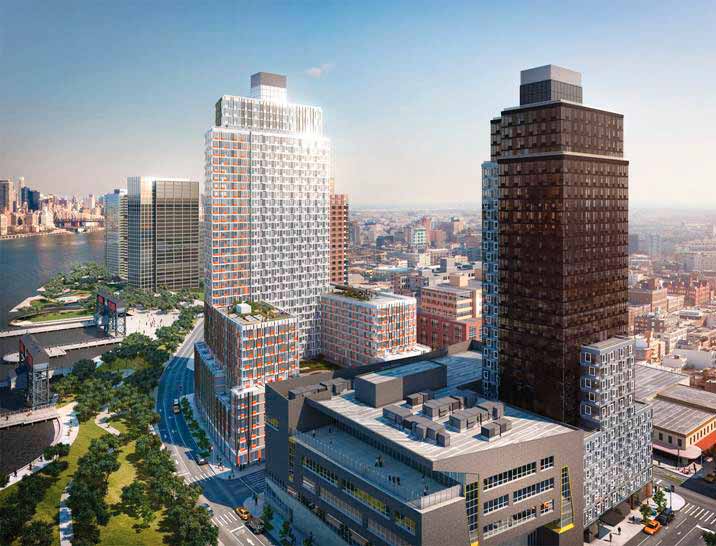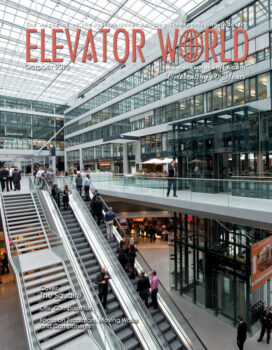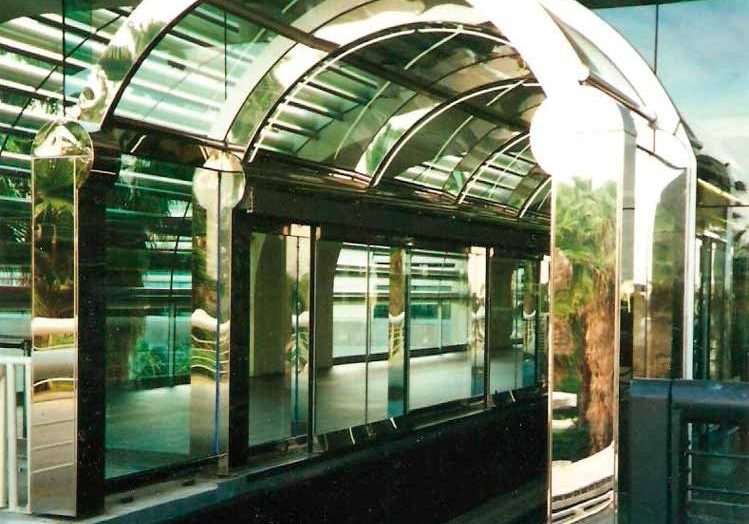North America and Mexico
Oct 1, 2013

A modest upswing in tall-building construction is giving the North American elevator industry a sense of optimism. Meanwhile, south of the border, Mexico is gaining a reputation as a viable place to build “up,” as its sometimes violent and corrupt history is being overshadowed by a quickly growing gross domestic product (GDP), burgeoning middle class and technological advances.
In North America, tall-building construction is spreading beyond the confines of city centers, such as in New York City (NYC), where towers are taking shape in Brooklyn and Queens, and Toronto, where the suburb of Mississauga is developing a reputation all its own. Mississauga’s new landmarks include the Absolute World Towers, a pair of 158-m-tall, 50-story, twisted residential towers (similar to Turning Torso in Malmö, Sweden) that have gained international acclaim and redefined the Mississauga skyline. NYC’s reputation as king of North American skyscraper construction has been in place since the early 1900s, and that shows no signs of changing anytime soon.
New York, New York!
The reasons for NYC’s dominance are obvious and longstanding, said Council on Tall Buildings and Urban Habitat (CTBUH) Editor Daniel Safarik. The main ones are the fact that the city holds a concentration of commercial power, and that land is scarce. Despite the recession, construction hasn’t slackened in Manhattan and is, in fact, spreading beyond its borders, he said. “Take a look at the Hudson Yards projects and the many towers that are now sprouting up in Brooklyn and Queens, in areas that were formerly low-rise industrial,” Safarik said. “If anything has changed, it’s that tall-building construction is no longer confined to Manhattan. The open secret is that towers across the river afford some of the best views of the Manhattan skyline,” he continued.
In McGraw Hill’s 2013 Dodge Construction Outlook, Vice President of Economic Affairs Robert A. Murray notes, “Major metropolitan areas such as New York continue to see groundbreaking on large apartment projects, along with condominium projects.” In the U.S., Murray forecasts new construction starts will rise 6% in 2013 to US$506 billion, following an 8% gain in 2012. Among the factors exerting a negative pull, Murray said, are persistent high unemployment, the inching up of mortgage rates and uncertainty about federal fiscal policy.
But, there are definite bright spots, some resulting from hardship. For example, rebuilding after Superstorm Sandy, which devastated parts of New York and New Jersey in October 2012, is marked by the development of Hunter’s Point South, which consists of a pair of residential towers on the East River facing Manhattan, and repair of the transportation hub for the World Trade Center, where Sandy-related flooding forced escalator contractors to start their half-finished work from scratch.
CTBUH’s list of tall buildings under construction in the U.S. and Canada reveals that most are residential or at least have a residential component. Safarik said this is a recent trend, gaining momentum after 2000. “In 1990, 89 of the 100 tallest buildings were offices, while in 2012, only 41 of the 100 [were] offices, and 53 [had] a residential component,” Safarik observed.
In the broadest sense, Safarik said, mass urbanization is driving this trend:
“People are concentrating in cities organically, because that is where economic opportunities increasingly exist. At the country level, reasons vary. China is force-relocating as many as 250 million people from rural areas into cities, accelerating the organic trend that would probably happen anyway over decades; instead, it will be compressed into 12 years. I would expect this tall residential (and mixed-use) trend to continue at least that long, even if China is the only country moving at that pace, simply because China is so enormous.”
In North America, Safarik said, real estate has become an attractive investment. “The going theory on this is that the volatility of other financial instruments in recent years has caused movement from stocks, commodities, bonds and derivatives to towers in places like New York, Miami and London,” he said. “It is true that more people are moving to cities in all kinds of markets, but in the First World, there is a high level of speculative real-estate activity going on, such that planners are wondering whether or how to limit absentee owners who rarely (if ever) occupy the apartments they have bought.”
In addition, Safarik said, the many small rooms characteristic of residential towers make them more flexible than, say, office buildings that have large, open floor plans. “It’s a lot easier to convert condos to apartments to hotels and vice versa, than it is to change offices into something else,” Safarik pointed out.
U.S.[1]
The U.S. economy is characterized as powerful and technologically advanced, especially in computers, the medical industry, aerospace and military equipment. Thanks to the deepest and longest downturn since the Great Depression, U.S. GDP contracted until the third quarter of 2009, when it started to turn around. Federal stimulus programs have helped, but questions remain over what kind of effect initiatives such as healthcare reform and government spending cuts will have.
- Population: 316.7 million
- Per-capita GDP: US$50,700
- GDP makeup: services, 79.9%; industry, 19%; agriculture, 1%
- Unemployment rate: 7.3%
- Population below poverty line: 15.1%
Canada: Stable, Steady and Strong
In many ways, Canada mirrors the U.S. in economic health and construction activity. The U.S.’s northern neighbor has its NYC in the form of Toronto, where similar construction scenarios are playing out. As the financial capital of Canada with one of the highest wealth concentrations, “it is experiencing many of the same pressures as New York, though on a smaller scale,” Safarik said. Projects such as an extended subway system in Toronto and the Absolute Towers in Mississauga point to intensifying urbanization, he said.
The crisis and subsequent recovery of the financial market resulted in a robust construction industry in Chicago, and the market continues to grow, said Ryan Wilson, senior vice president, ThyssenKrupp Elevator Ltd., Canada. “Canada was one of the bright lights following the financial crisis in 2008, and after the global financial system stabilized, there was a big influx of capital that came flowing into Canada,” Wilson said. When the country’s five chartered banks started to thrive again, legal, accounting and consulting firms also started to grow in downtown Toronto. “That really drove the commercial market,” Wilson said.
Toronto has become an epicenter of residential growth, as well, Wilson noted. “Urbanization is driving development downtown, just like in Manhattan or Chicago. Since land is at a premium, they have to go up,” he said. Like in major American cities, in Toronto, nearly every residential tower is at least 40 floors, he remarked. Over the past year and a half, there was a pause in residential tower construction in Canada’s urban centers based on the fear of oversupply, Wilson said, but now activity is coming back, and the hope is that there will be at least another five to 10 years of it.
The future also looks bright in Calgary, where tall-building construction is being driven by a healthy oil and gas sector, as well as business-friendly lawmakers, Wilson said. Recently announced projects include the 58-story, mixed-use TELUS Sky tower and the new 27-story Manulife office tower that will have Brion Energy as its anchor. They will join the recently opened, 57-story The Bow (ELEVATOR WORLD, September 2013), headquarters for Cenovus Energy and Encana Corp. “Alberta has a very strong provincial government, where there is not only a zero deficit culture, there is little to no debt,” Wilson said. Wilson described the overall Canadian economy as stable, steady and strong. “We’re not seeing massive growth like in India and China, but solid, steady growth,” he said.
In Calgary, Wilson predicts that additional residential construction will follow commercial activity as the energy sector adds employees and people seek places close to work to live. Continued growth in Calgary depends on the continued strength of the energy sector, but Wilson expects it to persist for at least another three to five years.
Although Calgary is emerging as a hotspot, Toronto remains tops. According to the 2013 CTBUH Awards Book, “The epicenter of Canadian tall-building development is Toronto, where 17 buildings taller than 150 m are under construction, more than any other city in the Western Hemisphere.” The book points out that by 2015, Toronto is projected to have 46 buildings taller than 150 m, up from 13 in 2005. Like New York, Toronto is concentrated, accounting for more than half of the 150-m-plus-tall buildings in Canada, despite having only 14.6% of the population. CTBUH says Toronto’s share of tall buildings nationwide is expected to grow to 61.3% by the end of 2015. Completions of buildings taller than 150 m in Toronto, according to CTBUH, are as follows:
- 2013: Eight
- 2014: 14
- 2015: Six
- 2016: One
For the elevator industry, Canada’s economic stability has created a not-entirely-unpleasant dilemma: “There is zero unemployment in our trade,” Wilson said. In fact, the industry is working collectively with governments and local academic institutions to implement and promote additional training. “The biggest issue the elevator industry is dealing with in Canada is how to handle the excess demand for elevators and to supply qualified manpower to complete the work that’s here,” Wilson said.
The balance sheets of Otis parent United Technologies Corp. (UTC) reflect this strength. During a Deutsche Bank Global Industrials and Basic Materials Conference in June, UTC Chief Financial Officer Gregory J. Hayes pointed to the performance of Otis North America as a bright spot among that of UTC’s various holdings. “Commercial construction — it’s actually been very positive for us here,” Hayes said. “We’ve had eight months in a row where the Architectural Billings Index has been over 50. We’re seeing expansion. The Otis North American business continues to see very good order growth year-over-year.”
Consumers are, by and large, confident, he said, cautioning that decisions coming out of Washington, D.C., such as healthcare reform could change that in the U.S. Heading out of 2013 and into 2014, Otis expects to remain strong, both in the U.S. and worldwide, based on orders placed in the first part of the year, Hayes said. During a July earnings conference call, Hayes said “very strong order momentum in North America” is one of the factors that promises to bring earnings back into growth mode after pressures in southern Europe and the overhaul of factories in the U.S. held them back.
Canada[1]
Sparsely populated compared with the U.S. and Mexico, Canada is a nation buoyed by its strong financial and energy sectors, and, to a large extent, its conservativeness. The U.S.’s largest supplier of oil and gas (fueled by Alberta’s oil sands, it has the third largest oil reserves behind Saudi Arabia and Venezuela), Canada was battered just as everyone else by the global financial crisis of 2008-2009, but its banking industry emerged “as one of the strongest in the world owing to the. . .tradition of conservative lending practices and strong capitalization.” This continues to drive impressive growth in Canada’s financial center and in its largest city, Toronto, while Calgary is seeing activity thanks to a strong energy market and, to a lesser extent, rebuilding from its June 2013 flood. As a high-tech society, Canada is similar to the U.S. in its production and high quality of life. It is part of the North American Free Trade Agreement (NAFTA) and the Canada-U.S. Free Trade Agreement.
- Population: 34.7 million
- Per-capita GDP: $43,400
- GDP makeup: services, 69.8%; industry, 28.5%; agriculture, 1.7%
- Unemployment rate: 7.3%
- Population below poverty line: 9.4%
Mexico: An Evolving Country
Mexico’s reputation as an economic powerhouse is gaining traction. Violence, crime and corruption still present challenges, but the nation’s economy is steadily improving, and the economic outlook is strong. One writer described today’s Mexico as “more like a crazy blend of the movies No Country for Old Men and The Social Network.”[2]
In Mexico City, residential and commercial construction is booming, with six towers taller than 150 m under construction, and one proposed, in the capital. “Most of the skyscrapers under construction are in Mexico City, and that is where the lion’s share of activity is taking place,” said Alicia Bandala, Managing Director for KONE Mexico. Mexico City is home to what is to be the tallest building in Latin America, Torre Mitikah, a 62-story hotel/residential building to stand 267 m tall when finished in 2016. Other emerging hotspots are Monterrey, where the 47-floor, 208-m-tall office/hotel Pabellón M is scheduled for completion in 2015, and Querétaro, site of the 2013 Global Cities Initiative International Forum, and a city and state with the highest GDP among Mexico’s 31 states, at 5.5%.[3]
KONE, which, along with Schindler, Otis and Mitsubishi, is a major player in Mexico, reports it has seen steady growth in the country in the last several years. KONE estimates there are approximately 51,000 elevators in operation, a number forecast only to grow. The growth is creating brisk business for elevator and escalator companies. Bandala reports KONE is supplying units to numerous Mexican tall buildings. For example, at Pabellon M, KONE is installing 28 escalators and 27 elevators, including 18 MiniSpace™ and 19 MonoSpace® units (the first machine-room-less elevator in the Mexico market) that range from 1-6 mps. It is also installing units at Peninsula Tower in Mexico City, a 180-m-tall, 51-story residential tower scheduled for completion next year. Bandala said the Mexican residential market is very strong “since people are moving closer to their jobs to avoid traffic jams in the city.” While tall buildings are being built, the vast amount of demand is still for units in low- and mid-rise buildings, she said. “Other cities in Mexico are still growing horizontally, since they have a lot of space for construction,” Bandala observed.
Although data on non-residential construction in Mexico is “scant and disperse,”[4] observers said the volume of activity is clearly on the upswing in places such as Mexico City. Furthermore, in July 2013, Mexican President Enrique Peña Nieto announced plans to invest some US$100 billion on rail, highway, port and telecommunications projects, but there is some doubt as to whether these plans will come to fruition, at least in their entirety.[5]
Bandala added that for the next five years, at least, the Mexican construction market looks healthy, thanks to an instrument similar to North America’s Real Estate Investment Trust giving the commercial market a boost. On the residential side, lower interest rates on mortgages are having a positive effect, she said. After five years, the health of Mexico’s construction market “will depend on new presidential elections and local economic developments.”
Stuart Prior, chief operating officer Latin America & Brazil for ThyssenKrupp Elevator Americas, echoes Bandala in his observation that “the Mexico elevator market is growing at a steady pace.” ThyssenKrupp Elevator, he said, feels optimistic about the long-term health of the country. Prior estimates overall demand for units in Mexico is approximately 1,000 per year.
Prior observed that housing complexes, shopping centers and offices are growing fastest, and he anticipates that Mexico City will see significant office construction in the coming years. Of the seven buildings in Mexico taller than 150 m that are being built, two are residential, two are office/hotel, one is hotel/residential, one is office/residential and one is office.[6] To provide an example of how many lifts such a building needs, the 225-m Torre BBVA Bancomer tower will have 31 lifts, including 29 passenger and two service elevators.
According to BBVA research, nonresidential construction is the lifeblood of the real-estate sector in Mexico, accounting for 80% of total production in 2000 and never falling below 50% since. It was 65% in 2012. Should Neito’s infrastructure projects come to pass, that trend will continue. The research continued, “employment generates greater demand for goods and services, which is why there are greater opportunities for the construction of shopping malls and public services such as schools and hospitals.”[8]
Mexico[1]
Mexico features a blend of outdated and modern industry and agriculture, and though it still struggles with violence, corruption and poverty, the nation’s clout as a viable economic power is growing. Part of NAFTA, Mexico has free-trade agreements with more than 60 countries, and more than 90% of its trade is under such agreements. Mexico’s GDP dropped 6.2% in 2009 as world export demand and investment fell. But, it has slowly and steadily climbed back to 4% in 2012, and structural economic reforms promised by the new presidential administration provide further reason for optimism.
- Population: 116.2 million
- Per-capita GDP: US$15,600
- GDP makeup: services: 61.8%; industry, 34.2%; agriculture, 4.1%
- Unemployment rate: 5%
- Population below poverty line: 51.3%
References
[1] CIA World Factbook.
[2] The New York Times, “How Mexico Got Back in the Game,” Thomas L. Friedman, February 23, 2013.
[3] “Finding the ‘New’ Mexico in Querértaro,” Joseph Parilla and Alan Berube, Brookings Institution, March 15, 2013.
[4] BBVA Research Real Estate Outlook Mexico, January 2013.
[5] Inter-American Dialogue, Latin America Advisor, July 25, 2013.
[6] CTBUH, The Skyscraper Center, Tall Building
Database: www.skyscrapercenter.com/create.php.
[7] e-architect, “BBVA’s New Corporate Headquarters in Mexico City, First Project by Rogers Stirk Harbour + Partners in Mexico,” July 7, 2009.
[8] BBVA Research, Real Estate Outlook Mexico, January 2013.
Get more of Elevator World. Sign up for our free e-newsletter.








